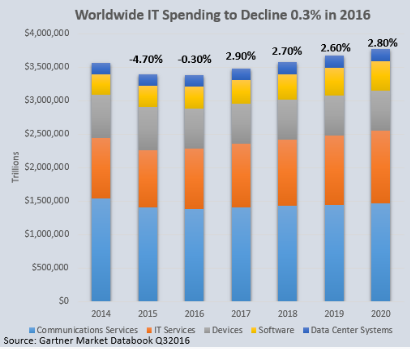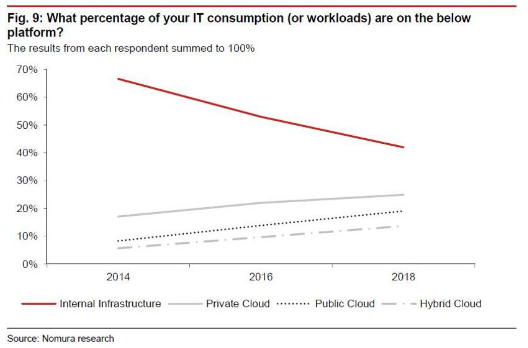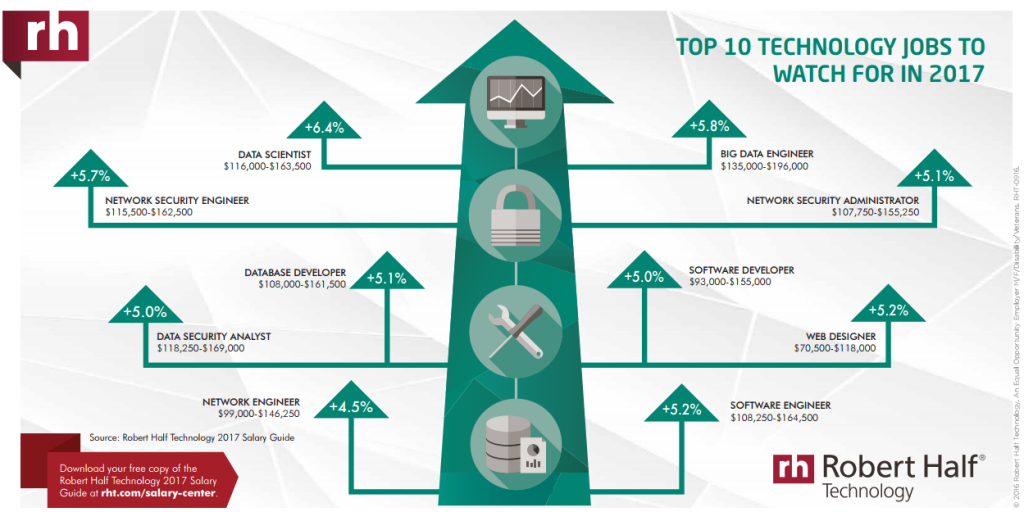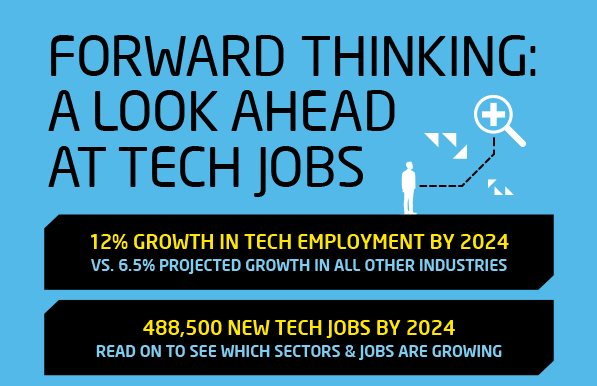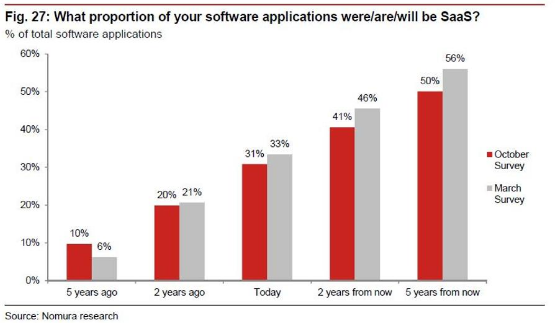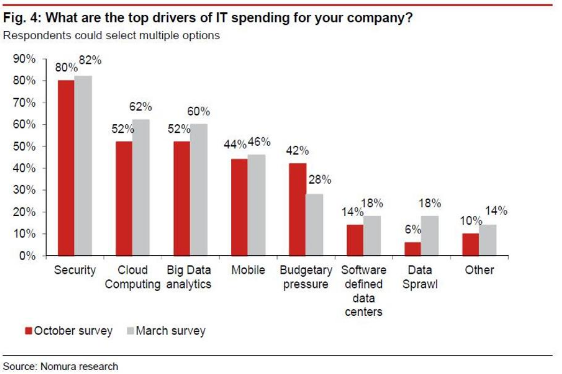What’s the impact for IT regarding the US Presidential Election or Brexit? How is the world economy going to be affected in 2017 for the IT world? Where do we stand regarding private, hybrid and public clouds consumption? Will companies put IT jobs in danger by migrating massively to the public cloud in the next couple of years? Those are some of the big questions a lot of people are asking right now.
Even though we can never know for sure, we can start analyzing and make some conjectures using some of the reports provided by companies that focus their jobs on doing that. Let’s take a look to some of the key research items available.
IT Spending Will Grow 2.9% Compared to 2016
Gartner report says we need to expect that the companies’ budget will spend 2.9% more in 2017 compared to 2016. Hitting a grand total of $3.5 trillion for the upcoming year.
The years 2015 and 2016 were actually declining years for IT. The budgets were reduced with significant numbers from 2014 to 2015 (estimated -5.5%), and from 2015 to 2016 with a minor reduction of -0.3%.
This almost 3% growth expected for 2017 will be a portion of the reduction we had since 2014. In order to obtain the same budget we had in 2014, IT needs to grow almost another 3%. At least we are on the right track.
Cloud will Represent Between 18 to 20% of the Existing Workloads in 2017/18
Nomura Holdings (Asia-headquartered financial services group with an integrated global network spanning over 30 countries) conducted a CIO survey with several conclusions regarding the cloud. One of the most important ones is represented in the expected growth of the cloud consumption, representing almost 20% of the entire workloads worldwide by 2018.
The curve that is clearly reducing significantly are the internal infrastructures, which does not represent private or hybrid clouds.
IT Jobs and their Salaries will Increase in 2017
There is always this idea going around in most people minds that the cloud initiative will, eventually, kill most of the IT jobs. That is simply not true. But, what we can guarantee for sure, is that the type of jobs will significantly change.
Definitely is going to be more about analytics related to IT, with the exponential increase of information we will definitely need ways to analyze this data in order to convert those into information. Some other changes we should expect are related to managing workloads in hybrid and public clouds instead of focusing on maintaining the hardware and OS. We can definitely discuss the expected shifts in a different article.
Robert Half Technology released its annual guide to U.S. tech salaries, which are increasing 3.6% in 2017. Here’s a list of the main IT jobs for 2017 and expected salaries:
- Network architect
- 2017 salary range: $125,000 – $183,000
- Raise: 4.4%
- Network security engineer
- 2017 salary range: $115,500 – $162,500
- Raise: 5.7%
- Wireless network engineer
- 2017 salary range: $113,250 – $158,000
- Raise: 4.5%
- Network security administrator
- 2017 salary range: $107,750 – $155,250
- Raise: 5.1%
- Network manager
- 2017 salary range: $102,250 – $153,000
- Raise: 3.4%
- Network engineer
- 2017 salary range: $99,000 – $146,250
- Raise: 4.5%
- Pre-sales engineer/technical engineer
- 2017 salary range: $92,250 – $140,000
- Raise: 3.9%
- Telecommunications manager
- 2017 salary range: $90,000 – $130,000
- Raise: 3.0%
- Network administrator
- 2017 salary range: $78,000 – $117,750
- Raise: 4.0%
- Telecommunications specialist
- 2017 salary range: $63,000 – $98,000
- Raise: 2.9%
Those were not enough good news? Well, Modis has also completed a report with a forecast related to technology jobs in the year 2024. The main conclusion: 12% increase in tech employment (vs 6.5% compared with other industries). That 12% represents an estimated number of 488,500 new jobs by 2024.
In this report, you can also find more information related to IT jobs and salaries for 2017.
In 2017 is Predicted that 46% of the Applications will be SaaS-based for top CIOs
Nomura Holdings also analyzed with the CIOs the Software-as-a-Service applications, increasing from 33% up to 46% between 2015 and 2017.
One of the biggest players within the SaaS based platforms is SalesForce, which is increasing year over year the number of customers and earnings.
CIOs are Prioritizing Big Data Analytics, Cloud Computing and Security in 2016/2017
Nomura Holdings included in the survey to the CIOs, what are the top priorities for 2016 and 2017 for IT budgets: Security, Cloud and Big Data Analytics was the answer.
Security is by far the top priority in CIOs mind right now. The shifting world with cloud initiatives puts a lot of concerns in the main stakeholders for IT regarding their information and how people are accessing it.
Final Thought for those IT Guys Out There
We should stop worrying about keeping our jobs and use more of that time on getting better, learning new technologies, take these trends in order to direct ourselves to be better professionals and be part of the important aspects in our company.
Too many people keep thinking on just staying in the same zone where we work, doing the same routine to do “only what the company is paying me for”. Go, IT guy put your mind away from the concerns about losing your job, and get better no matter what you do, not for the company, for you. After all, “life begins outside your comfort zone”, right?


